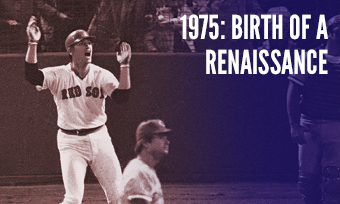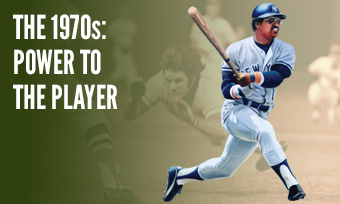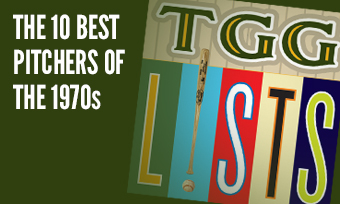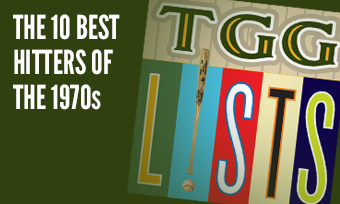The Yearly Reader
Leaders and Honors, 1975
Our list of baseball’s top 10 hitters and pitchers in both the American League and National League for the 1975 baseball season, as well as the awards and honors given to the game’s top achievers of the year.
The National League’s Top 10 Hitters, 1975
Bold type in brick red indicates league leader.
1. Joe Morgan, Cincinnati
Key Numbers: .327 average, 107 runs, 27 doubles, 6 triples, 17 home runs, 94 RBIs, 132 walks, 67 stolen bases, .466 on-base percentage.
The above numbers should be enough hyperbole to describe Morgan’s well-deserved MVP effort.
2. Greg Luzinski, Philadelphia
Key Numbers: .300 average, 85 runs, 179 hits, 35 doubles, 34 home runs, 120 RBIs, 89 walks, 17 intentional walks, .540 slugging percentage.
Last year it was Mike Schmidt’s turn; now it was the equally young and talented Luzinski, who showed how dominant he could be as long as injuries stayed out of the picture. It was his first of three straight .300 campaigns—the only three of his career.
3. Mike Schmidt, Philadelphia
Key Numbers: .249 average, 93 runs, 34 doubles, 38 home runs, 95 RBIs, 101 walks, 180 strikeouts, 29 stolen bases.
Twenty-six years before Bobby Abreu became the Phillies’ first 30-30 man (30 homers, 30 steals), Schmidt fell short of the achievement by one stolen base.
4. Johnny Bench, Cincinnati
Key Numbers: .283 average, 83 runs, 39 doubles, 28 home runs, 110 RBIs, 11 stolen bases, 0 caught stealing.
Odd stat of the year: Bench, a 50-50 proposition in those rare moments when he was called upon to steal a base, swiped 11 without once getting caught in 1975.
5. Pete Rose, Cincinnati
Key Numbers: 162 games, .317 average, 662 at-bats, 112 runs, 210 hits, 47 doubles, 7 home runs, 74 RBIs, 89 walks, 11 hit-by-pitches, 0 stolen bases.
Other odd stat of the year: Rose, well branded as Charlie Hustle, played 162 games in 1975 and, for the only time in his career, didn’t successfully steal a base.
6. Ted Simmons, St. Louis
Key Numbers: .332 average, 80 runs, 193 hits, 32 doubles, 18 home runs, 100 RBIs.
His subpar defense notwithstanding—he led the majors in stolen bases allowed (96) and passed balls (28)—Simmons was somehow spurned from the All-Star roster despite, among other exploits, setting the all-time season record for hits by a catcher.
7. Dave Parker, Pittsburgh
Key Numbers: .308 average, 172 hits, 35 doubles, 10 triples, 25 home runs, 101 RBIs, .541 slugging percentage.
Even bigger and burlier (6’5”, 230 pounds) than star teammate Willie Stargell, Parker said he was done with being platooned and threatened a trade if the Pirates didn’t give him an everyday role. After the above numbers, any such discussion came to a quick end.
8. Willie Stargell, Pittsburgh
Key Numbers: 124 games, .295 average, 32 doubles, 22 home runs, 90 RBIs.
A broken rib suffered in midsummer put an end to what looked to be a typically Ruthian effort for Stargell; he bashed only two home runs over his final 38 games.
9. Steve Garvey, Los Angeles
Key Numbers: .319 average, 85 runs, 210 hits, 38 doubles, 6 triples, 18 home runs, 95 RBIs, 11 stolen bases.
Garvey’s harmless self-promotional character began to grate on Dodgers teammates, but his on-field play continued to justify his American idol status.
10. Cesar Cedeno, Houston
Key Numbers: 131 games, .288 average, 93 runs, 31 doubles, 13 home runs, 63 RBIs, 50 stolen bases, 17 caught stealing.
A down year for the sixth-year Astro—still just 24 years of age—was redeemed as he hit .350 with seven of his home runs over his final 41 games after suffering a broken finger in midsummer.
The American League’s Top 10 Hitters, 1975
1. Fred Lynn, Boston
Key Numbers: .331 average, 103 runs, 175 hits, 47 doubles, 7 triples, 21 home runs, 105 RBIs, 10 stolen bases, .566 slugging percentage.
The remarkable Red Sox rookie statistically showed no mental first-year wilting under the pressure; he hit over .300 in each month of the season, and .389 with runners in scoring position.
2. John Mayberry, Kansas City
Key Numbers: .291 average, 95 runs, 38 doubles, 34 home runs, 106 RBIs, 119 walks.
While Lynn stole the headlines among AL hitters, Mayberry’s immense numbers undoubtedly made him the sleeper of the year.
3. Rod Carew, Minnesota
Key Numbers: .359 average, 89 runs, 192 hits, 14 home runs, 80 RBIs, 18 intentional walks, 35 stolen bases, .421 on-base percentage.
The fact that the light-hitting Carew was just one home run off the team lead suggested this: How much more pumped up would his overall numbers been had he played with the more formidable Twins of a decade earlier, with peak-form Harmon Killebrew, Tony Oliva and Bob Allison surrounding him in the lineup?
4. Toby Harrah, Texas
Key Numbers: .293 average, 81 runs, 20 home runs, 93 RBIs, 98 walks, 23 stolen bases.
Just three years earlier a one-homer guy, Harrah opened his stance and ginned up the punch to become a more feared all-around offensive presence.
5. Bobby Bonds, New York
Key Numbers: .270 average, 93 runs, 26 doubles, 32 home runs, 85 RBIs, 89 walks, 30 stolen bases.
Off of two new Yankees (Catfish Hunter being the other) transplanted from the Bay Area, Bonds began a period in his career with occasional production, constant frustration, and the moving company’s phone number always on speed dial.
6. Reggie Jackson, Oakland
Key Numbers: .253 average, 91 runs, 39 doubles, 36 home runs, 104 RBIs, 17 stolen bases.
In his ninth and last year at Oakland—at least, until a 1987 swan song to mentor Jose Canseco and Mark McGwire—Jackson led the AL in home runs for the second of four times.
7. Ken Singleton, Baltimore
Key Numbers: .300 average, 88 runs, 176 hits, 37 doubles, 15 home runs, 55 RBIs, 118 walks.
Though his power numbers were subpar by his standards, Singleton proved his first-year value with the Orioles by reaching base safely (295 times) more than any other AL player.
8. George Brett, Kansas City
Key Numbers: .308 average, 634 at-bats, 84 runs, 195 hits, 35 doubles, 13 triples, 11 home runs, 90 RBIs, 13 stolen bases.
Only Rod Carew would hit more triples among AL players during the 1970s than Brett—even as he didn’t begin playing every day until 1974. The second-year Royal led the circuit in three-baggers for the first of three times over a five-year period.
9. Boog Powell, Cleveland
Key Numbers: 134 games, .297 average, 27 home runs, 86 RBIs.
Master of the Comeback Player of the Year award, Powell joined former teammate Frank Robinson (now managing the Indians) and came alive once more after a couple seasons of assumed fadeout.
10. Jim Rice, Boston
Key Numbers: .309 average, 92 runs, 174 hits, 29 doubles, 22 home runs, 102 RBIs, 10 stolen bases.
Fred Lynn was not a unanimous Rookie of the Year choice, as one voter split his first-place vote between Lynn and co-rookie teammate Rice.
The National League’s Top 10 Pitchers, 1975
1. Randy Jones, San Diego
Key Numbers: 2.24 ERA, 20 wins, 12 losses, 36 starts, 18 complete games, 6 shutouts, 285 innings, 56 walks, 35 grounded into double plays.
Randy Jones’ luck went in reverse, winning 20 after losing 22 the year before as his improved sinker raised the Padres out of last place for the very first time.
2. Andy Messersmith, Los Angeles
Key Numbers: 2.29 ERA, 19 wins, 14 losses, 1 save, 42 appearances, 40 starts, 19 complete games, 7 shutouts, 321.2 innings, 24 grounded into double plays.
Messersmith pitched like a million—and that’s what he’d soon be worth after playing out his famous option year that the Lords would later regret.
3. Tom Seaver, New York
Key Numbers: 2.38 ERA, 22 wins, 9 losses, .710 win percentage, 36 starts, 280.1 innings, 243 strikeouts, 24 stolen bases allowed, 15 caught stealing/picked off.
On September 24 at Chicago, Seaver—who won his third and last Cy Young Award—came within an out of nine no-hit innings, but not a no-hitter as a scoreless game continued into extra innings.
4. Jerry Reuss, Pittsburgh
Key Numbers: 2.54 ERA, 18 wins, 11 losses, 32 starts, 6 shutouts, 237.1 innings, 29 grounded into double plays.
For the fifth straight year, Reuss dropped his ERA from the previous season—and this was his biggest one yet, shaving a run off his 3.50 figure of 1974.
5. Burt Hooton, Chicago-Los Angeles
Key Numbers: 3.07 ERA, 18 wins, 9 losses, 33 starts, 234.2 innings.
Hooton finally fulfilled high expectations in Los Angeles after an early-season trade from Chicago, where he experienced several years of frustration.
6. Doug Rau, Los Angeles
Key Numbers: 3.11 ERA, 15 wins, 9 losses, 38 starts, 257.2 innings, 61 walks.
The Texan southpaw broke away from a mundane season to date on August and went 6-0 over his final 10 decisions.
7. Don Gullett, Cincinnati
Key Numbers: 2.42 ERA, 15 wins, 4 losses, .789 win percentage, 22 starts, 159.2 innings.
What should have been an easy 20-win campaign for Gullett was interrupted by a broken thumb from a comebacker that forced a two-month hiatus upon him.
8. Al Hrabosky, St. Louis
Key Numbers: 1.66 ERA, 13 wins, 3 losses, .813 win percentage, 22 saves, 6 blown saves, 65 appearances, 97.1 innings.
Hrabosky emerged as one of baseball’s more theatrical closers, stalking behind the mound between batters to psyche up himself—and psyche out his opponents.
9. Bob Forsch, St. Louis
Key Numbers: 2.86 ERA, 15 wins, 10 losses, 34 starts, 230 innings, 26 grounded into double plays.
In his first full season, Forsch showed strong athleticism on the mound with the above numbers—and at the plate with a .303 average within 78 at-bats with three doubles, three triples and a home run.
10. Don Sutton, Los Angeles
Key Numbers: 2.87 ERA, 16 wins, 13 losses, 35 starts, 254.1 innings.
Calmed by hypnosis and enrichened with the largest contract ($312,000 over two years) given by the Dodgers to date, Sutton pitched well enough to finally secure a 20-win record—but was denied mostly by a DOA Dodgers offense that gave him only 2.3 runs per start when he didn’t get the victory.
The American League’s Top 10 Pitchers, 1975
1. Jim Palmer, Baltimore
Key Numbers: 2.09 ERA, 23 wins, 11 losses, .676 win percentage, 1 save, 38 starts, 25 complete games, 10 shutouts, 323 innings, 29 stolen bases allowed, 32 grounded into double plays.
After his 1974 campaign was derailed by a sore arm, Palmer returned to world-class standing with his second AL Cy Young Award and 10 shutouts—the last American Leaguer to reach double-digits.
2. Catfish Hunter, New York
Key Numbers: 2.58 ERA, 23 wins, 14 losses, 39 starts, 30 complete games, 7 shutouts, 328 innings.
Catfish Hunter took his act from the Oakland Circus to the Bronx Zoo, and skipped nary a beat to the elation of Yankees fans.
3. Frank Tanana, California
Key Numbers: 2.26 ERA, 16 wins, 9 losses, 33 starts, 257.1 innings, 269 strikeouts, 20 caught stealing/picked off.
“Second Banana Tanana,” playing the role of Nolan Ryan’s protégé, ended up winning the AL strikeout crown over Ryan—who missed the season’s last six weeks to deal with postseason bone chip surgery.
4. Mike Torrez, Baltimore
Key Numbers: 3.06 ERA, 20 wins, 9 losses, .690 win percentage, 36 starts, 270.2 innings, 133 walks, 12 wild pitches, 35 grounded into double plays.
Along with Ken Singleton, Torrez’s first-year presence made it easy to declare the Orioles’ trade to get them both from Montreal for a fading Dave McNally as the steal of the year.
5. Goose Gossage, Chicago
Key Numbers: 1.84 ERA, 9 wins, 8 losses, 26 saves, 5 blown saves, 62 appearances, 141.2 innings.
It seemed almost amazing that the White Sox would even need a closer with Wilbur Wood and Jim Kaat engorging on innings, but they got a real good one in Gossage—who broke out after three infuriating first years (4.93 ERA) with in Chicago.
6. Vida Blue, Oakland
Key Numbers: 3.01 ERA, 22 wins, 11 losses, 1 save, 38 starts, 278 innings, 23 stolen bases allowed, 26 grounded into double plays.
With Catfish Hunter snatched away to New York on a technicality, Blue picked an excellent time to put together his best numbers since his memorable full-season debut in 1971.
7. Jim Kaat, Chicago
Key Numbers: 3.11 ERA, 20 wins, 14 losses, 41 starts, 303.2 innings, 31 grounded into double plays.
The 36-year-old southpaw continued his second wind in the Second City, accumulating more innings than even ironman teammate Wilbur Wood.
8. Rudy May, New York
Key Numbers: 3.06 ERA, 14 wins, 12 losses, 31 starts, 212 innings, 99 walks.
Left for dead by the Angels after nearly a decade with the organization, the Yankees took a chance on May and he responded, thanks to adjustments to both his pitching mechanics and his mental health.
9. Ken Holtzman, Oakland
Key Numbers: 3.14 ERA, 18 wins, 14 losses, 38 starts, 266.1 innings, 108 walks.
Holtzman was one out away from a third career no-hitter on June 8 when the Tigers’ Tom Veryzer doubled against him at Oakland.
10. Gaylord Perry, Cleveland-Texas
Key Numbers: 3.24 ERA, 18 wins, 17 losses, 37 starts, 25 complete games, 305.2 innings.
A very productive but short tenure in Cleveland came to an end for Perry as he clashed with manager Frank Robinson; he found solace in Texas after a midseason trade to the Rangers.









